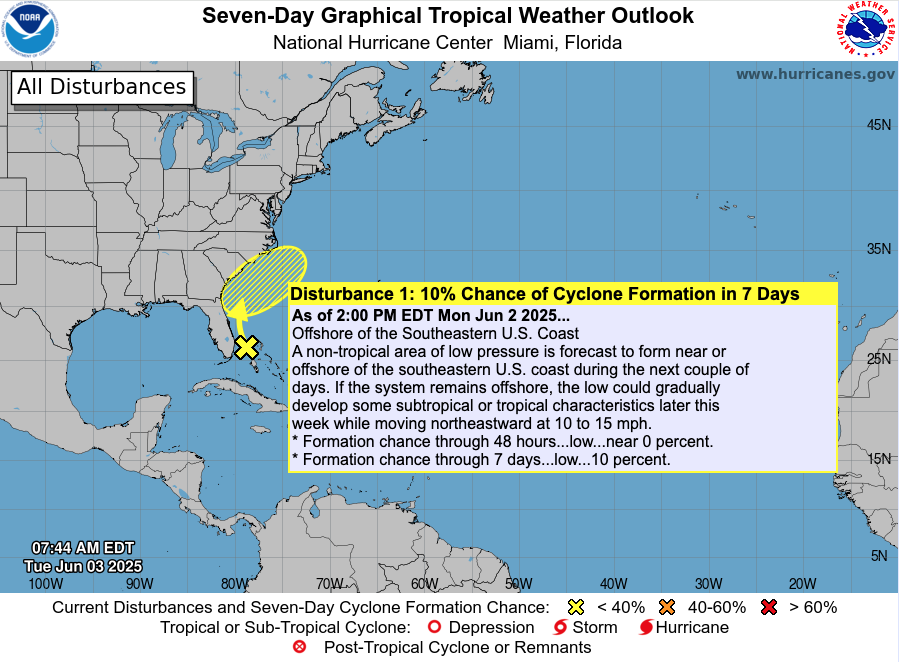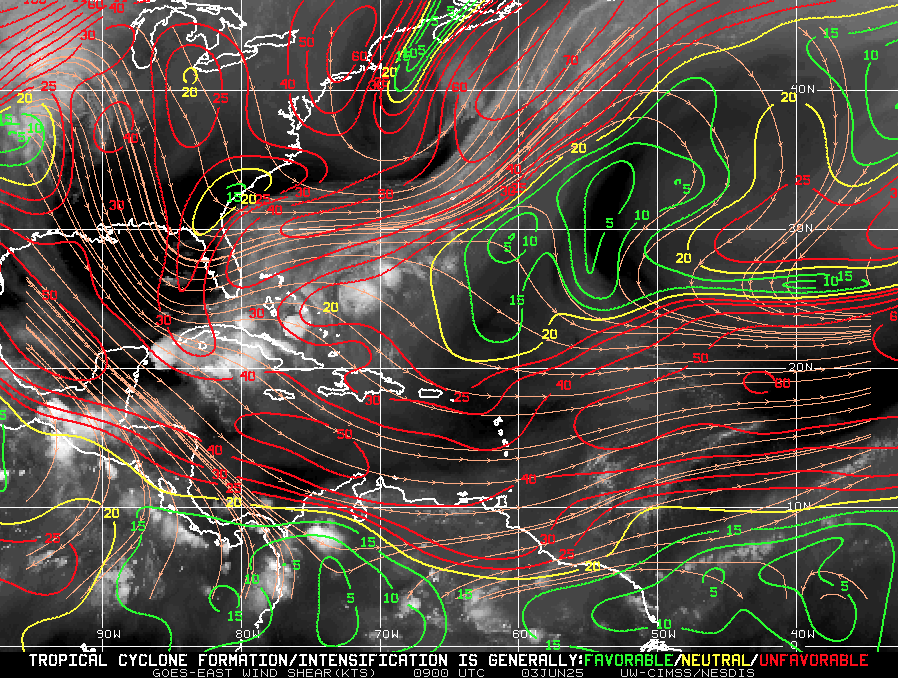Atlantic Hurricane Outlook – June 12, 2025: Dusty Skies, Quiet Tropics
The Atlantic basin remains quiet with no tropical activity expected over the next week. Strong Saharan dust suppresses storm development and reduces air quality across Florida, but warming waters and easing wind shear hint at increased hurricane potential later in June.
As we move through the second week of the Atlantic hurricane season, the basin remains quiet. There are no active tropical cyclones, no areas of interest, and no expected development over the next 7 days, according to the National Hurricane Center’s 2 AM EDT outlook. While this calm is typical for early June, forecasters are keeping an eye on evolving conditions that could shift toward tropical development later this month.
Atlantic Basin: Still and Stable
No tropical systems are on the map, and the 7-day outlook remains clear. The Atlantic basin continues its quiet streak, consistent with climatology for early June. However, this calm will not last forever, and underlying signals suggest more favorable conditions could emerge by late June or early July.
Satellite image courtesy of Windy.com
Sea Surface Temperatures: Warm and Ready
Ocean waters across the Atlantic basin are trending warm, offering potential fuel for future storms.
Gulf of America (Mexico): Low to mid-80s°F (28–30°C), above average in many spots.
Western Caribbean: Warm and supportive of tropical development later in the season.
Main Development Region (MDR): Warmer than normal for this time of year, laying the groundwork for long-track systems from Africa.
Sea surface temperature data courtesy of Windy.com
Atmospheric Conditions: Slowly Trending Toward Favorable
While the Atlantic remains quiet, the atmosphere is showing signs of gradual change.
Wind Shear remains moderate to high across parts of the Caribbean and central Atlantic, still limiting storm formation. However, global models suggest a slow reduction in shear over the coming weeks.
Mid-level moisture is increasing across the Caribbean and Gulf—helpful for deep convection and thunderstorms.
These subtle shifts are typical precursors to an uptick in tropical activity as the season matures.
Wind Shear Courtesy of https://tropic.ssec.wisc.edu/
Saharan Air Layer: Strong and Dusty
A massive plume of Saharan dust is stretching across the Atlantic and reaching Florida and the Gulf Coast today.
The dry air and strong upper-level winds associated with the Saharan Air Layer (SAL) are suppressing tropical development.
This dust layer is also reducing air quality and visibility in parts of Florida and the Southeast, especially for those with respiratory conditions.
The SAL is expected to remain dominant into mid-to-late June before it begins to weaken.
Dust/SAL data courtesy of Windy.com
Thunderstorm Activity: Mostly Local and Non-Tropical
Convective activity across the Atlantic basin is minimal and disorganized.
Florida: Hazy skies and isolated afternoon thunderstorms are expected, but nothing tropical in nature.
Western Caribbean and Off the U.S. East Coast: Scattered showers remain unorganized.
Thunderstorm data courtesy of Windy.com
Florida Forecast: Dusty Skies, Humid Air
Highs: Upper 80s to low 90s°F (31–33°C)
Skies: Hazy due to Saharan dust
Rain Chances: Scattered PM thunderstorms possible
Air Quality: Reduced in some areas—sensitive groups should take precautions
Winds: Light and variable
Rain data courtesy of Windy.com
Prep Tip of the Day: Protect Your Lungs and Finalize Your Plan
Use the quiet to finalize your hurricane prep, especially while dusty skies dominate:
Limit outdoor activity if you’re sensitive to dust or pollen
Replace or clean air filters in your home and car
Check that your family communication plan and evacuation routes are up to date
Store key websites in your browser bookmarks: hurricanes.gov, Cat5Prep.com
Looking Ahead: The Table Is Being Set
While the tropics are calm today, the pieces are slowly moving into place for increased activity later this month. Warm waters, a gradual easing of wind shear, and rising moisture hint at a more active pattern on the horizon. Stay vigilant, and check back daily for updates.
Atlantic Hurricane Outlook – June 11, 2025: Quiet Tropics Continue Amid Rising Possibilities
he Atlantic basin remains calm on June 11, 2025, with no tropical storms or disturbances expected over the next week. However, warming sea surface temperatures and easing atmospheric barriers hint at increased hurricane activity later this month. Stay prepared with daily updates from Cat5Prep.com.
The twelfth day of the 2025 Atlantic hurricane season opens with calm conditions—no tropical storms, depressions, or areas being actively monitored. According to the National Hurricane Center (NHC), no tropical cyclone formation is expected over the next seven days. The basin remains in an early-season lull, but the combined presence of warm water and easing atmospheric barriers demands continued attention.
Atlantic Basin: Clear Today, But Shifts Are Underway
Active Systems: Zero
Disturbances: None
Tropical Formation Outlook: No development expected through June 18, 2025.
This state of inactivity is consistent with early June climatology. Still, meteorologists point out that subtle environmental shifts are in motion beneath the surface.
Satellite imagery courtesy of Windy.com
Sea Surface Temperatures: A Growing Foundation
Gulf of America (Mexico) & Western Caribbean: Steady low- to mid‑80s °F (27–29 °C), ideal for fuel if storms form
Main Development Region (MDR): Sea surface temperatures are trending above normal for early June
These warm waters persist as a critical energy reserve for potential fast-moving tropical systems.
Sea surface temperature data courtesy of Windy.com
Wind Shear & Moisture: Gradual Improvements
Wind Shear: Moderate to high across much of the basin, suppressing storm development
Moisture: Midlevel humidity is slowly climbing in the Gulf and Caribbean—supporting the formation of deeper convection
This evolving balance suggests the atmosphere may be priming for tropical cyclones in the coming weeks.
Wind Shear Courtesy of https://tropic.ssec.wisc.edu/
Saharan Air Layer: A Continuing Deterrent
An active plume of Saharan dust covers the central and eastern Atlantic, suppressing convection and reinforcing vertical wind shear
This protective layer is expected to weaken by late June, enabling better conditions for tropical wave development
Saharan Air Layer (SAL) data courtesy of Windy.com
Thunderstorm Activity: Local, Non-Tropical
Florida & Southeast U.S.: Expect isolated afternoon storms—standard for this time of year
Western Caribbean: A few clusters of showers persist but remain disorganized
Central Atlantic: Remains convection-free with no signs of tropical wave development
Thunderstorm data courtesy of Windy.com
Florida Forecast (Statewide)
Highs: Upper 80s to low 90s °F (31–33 °C)
Humidity: Moderate to high—classic muggy summer conditions
Rain: Scattered midday and afternoon thunderstorms
Winds: Light and steady
Rainfall data courtesy of Windy.com
Prep Tip of the Day: Check NOAA Weather Radio
Take advantage of quiet skies to:
Test your NOAA Weather Radio
Confirm you are signed up for mobile and text alert services
Ensure your emergency gear is functional and accessible
Staying alert now reduces stress later.
Looking Ahead: Remain Alert, Not Alarmed
While no tropical formations are expected through June 18, the convergence of:
Persisting warm SSTs
Weakening wind shear
And waning Saharan dust
set the stage for increased activity during the latter half of June.
Stay connected to Cat5Prep.com for your daily update and tracking as the tropical season progresses.
Atlantic Hurricane Outlook – June 3, 2025: Conditions Ripening Beneath the Calm
The 2025 Atlantic hurricane season starts quietly, but today, June 3, 2025, the National Hurricane Center identifies a new low-pressure area off the Southeastern U.S. coast. Conditions are slowly becoming more favorable for storm development this week.
The third day of the 2025 Atlantic hurricane season begins much like the last—quiet skies and no named systems. But meteorologists are watching closely. While there are no storms on the map, the ingredients for tropical cyclone formation are slowly assembling. Sea surface temperatures are rising, atmospheric inhibitors are weakening, and thunderstorm activity is beginning to build in key regions. It’s still early—but don’t get too comfortable.
Atlantic Basin: New Area of Interest and Overall Quiet
As of yesterday afternoon’s update from the National Hurricane Center (NHC), a new area of low pressure has been identified just off the southeastern United States coast:
A non-tropical area of low pressure is expected to form near or offshore of the southeastern U.S. coast in the next couple of days.
If it remains offshore, it could gradually acquire subtropical or tropical characteristics later this week while tracking northeastward at 10 to 15 mph.
Formation chance through 48 hours: Low (near 0%)
Formation chance through 7 days: Low (10%)
While development is currently unlikely, this is the first flagged area of interest in the Atlantic this season — a reminder that conditions are slowly trending more favorable. Models will continue to be monitored for any shifts in track or intensity.
At this time, no direct impacts are expected for the U.S. mainland, but boaters and beachgoers along the Southeast Coast should monitor local marine conditions later this week.
Otherwise, the basin remains quiet:
No active tropical cyclones
No other areas of interest
No tropical development expected in the next 7 days
A quiet start like this is typical for early June but it’s not a signal to let your guard down. The long-range outlook hints at increasing activity potential by mid-to-late June, especially in the western Caribbean and Gulf of America (Mexico).
Satellite imagery courtesy of Windy.com
Sea Surface Temperatures: Storm Fuel Is Already in Place
Warm waters are the engine that powers hurricanes, and the Atlantic is already running hot:
Gulf of America (Mexico): 2–4°F above average, with widespread 86°F+ (30°C) readings
Western Caribbean: Elevated SSTs continue to build near Central America and Cuba
Main Development Region (MDR): Trending warmer than normal, with the potential to support long-track storms later this season
These above-average temperatures are primed to support rapid intensification once storm systems begin to form.
Sea surface temperature data courtesy of Windy.com
Wind Shear & Moisture: A Shifting Balance
Wind shear—the atmospheric force that disrupts hurricane development—is weakening, especially in the Caribbean and Gulf. At the same time, moisture levels in the lower and mid-atmosphere are rising.
This combination supports stronger thunderstorms and vertical cloud development—key precursors for tropical formation.
Wind-shear Map Image Courtesy of : https://tropic.ssec.wisc.edu/
Saharan Air Layer: Dust Is Holding Steady—for Now
A broad stretch of the Saharan Air Layer (SAL) is still active across the central and eastern Atlantic:
Dry, stable air disrupts tropical wave development
Increased wind shear limits vertical convection
Dust particles reduce storm cloud organization
While the SAL continues to offer some protection in the eastern Atlantic, it’s expected to weaken later this month—removing one of the last early-season barriers to storm growth.
Satellite dust data courtesy of Windy.com
Thunderstorm Activity: Not Just Summer Weather
While today’s thunderstorms aren’t tropical, their growing presence is important:
Western Caribbean: Clusters of convection are forming, though currently disorganized
Southeastern U.S. & Gulf Coast: Expect afternoon storms, fueled by heat and humidity
These storm systems help prime the atmosphere for eventual tropical development and are often the earliest signs of areas of interest.
Thunderstorm data courtesy of Windy.com
Florida Forecast: A Classic, Stormy Summer Day
Expect another typical early June day across the Sunshine State:
North Florida: Upper 80s, low humidity, mostly clear
Central Florida: Around 90°F with building humidity and scattered PM storms
South Florida: Mid-80s, muggy, with increased chances of storms after 2 PM
Though today’s storms are not tropical, the overall pattern is signaling a slow seasonal transition.
Forecast radar imagery courtesy of Windy.com
Prep Tip of the Day: Get Ahead While It’s Quiet
This calm window is the perfect time to prepare:
Review your hurricane plan and local evacuation routes
Restock your hurricane kit—especially water, batteries, and medications
Take photos of your home and valuables for insurance
Sign up for local emergency alerts and bookmark Cat5Prep.com
Know the difference between a watch and a warning before one is issued
Looking Ahead: No Storms Now, But Don’t Let That Fool You
Though nothing is spinning in the Atlantic today, all signs point to rising potential in the weeks ahead. Sea temperatures are already warm enough to support hurricanes. Wind shear is fading. Moisture and thunderstorm activity are increasing.
We are not forecasting imminent development—but the environment is evolving fast.
Check back tomorrow for your daily hurricane update from Cat5Prep.com.







